Hey, in case you don’t know who I am, my name is Will Mitchell.
And Startupbros was started way back in 2012 to help people quit their 9 to 5 job.
We knew that we wanted to start something awesome but never imagined it would be what it is today.
Now…this post is going to walk you through everything you need to launch the best blog possible.
Because we want you to do something you love!
For some motivation, here’s a look at our beautiful website the first month we launched!
Plus the goals 16 year old me wanted…
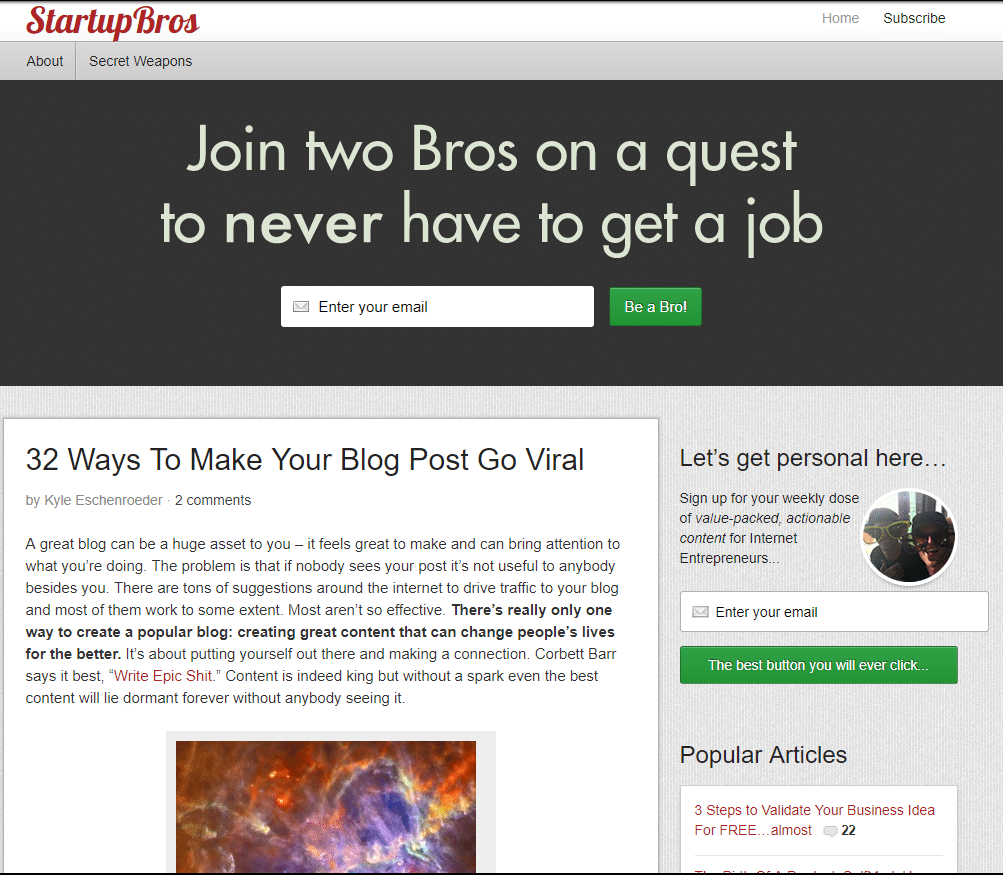
Pretty fancy huh?…
Truth is,
…there are really only 4 main steps necessary to launch a successful blog:
Table of Contents
But First Find Your Why
You can make blogging a full-time income and it’s possible to do it in a relatively short amount of time.
Try to answer this:
Why do you, in particular, want to start a blog?
And is there something you’re passionate about that you want to share with the world?
Starting a blog can be a way for you to leverage your time and finally quit the daily grind of driving into work every day.
You can work anywhere you want and focus every day on the things you love.
It’s incredible to connect with people all over the world about a topic you’re passionate about.
So this post is written to help you finally take the plunge and not only start a successful blog but launch it the right way to generate traffic!
Blogging can be a lot of things…
- A place to learn
- It’s a platform where we can share our knowledge and become authorities
- It can be a full time job and an excellent way to make money
- It can be your very own digital business
So now, here’s where we are. You’ve made the decision to start a blog… and the question you’re asking yourself is… how do I get started?
In fact, we are going to help you get your blog set up in about 30 minutes or less. You just need to keep reading and follow the steps and tips we have for you here.
When starting a blog, you need to prepare to:
- Make the commitment
- Prioritize your time
- Find your niche
- Engage in continuous research
- Find and develop your tone
- Pinpoint your strong points and what works for you
- Work on your weaknesses and eliminate what doesn’t work for you
Let’s go over the steps involved with starting your first successful blog.
1. Choose Your Blogging Platform
Without over complicating the explanation, the blogging platform is the software that you will use to manage and edit your blog and posts.
This is where you will go to create or update your blogs, from the content to the images and videos, etc.
These are the most popular blogging platforms out there:
- Wordpress.org
- Wix
- Wordpress.com
- Medium
- Squarespace
- Weebly
“Wix, Squarespace and Weebly are great for local businesses looking for a professional website. But for blogging and the customization needed to grow it into a business then WordPress.org is the obvious choice”
WordPress is the most widely used and popular platforms for blogging, and we highly recommend it.
Most everyone in the blogging world will likely suggest that you use WordPress, and for good reason.
Because it allows for the ultimate customization of your layout, content creation, and gives you the option to expand your blog as it grows.
After the next step – choosing your web host and domain name – you will need to install WordPress, which we will get to in a bit.
What is the difference between WordPress.com and WordPress.org?
Wordpress.com hosts your content on their platform. Similar to posting on social media. You don’t own the content, the website does.
Wordpress.org, on the other hand, is self-hosted meaning you own the content on your own platform. This allows you to find your own reliable hosting provider and you control what happens on your website.
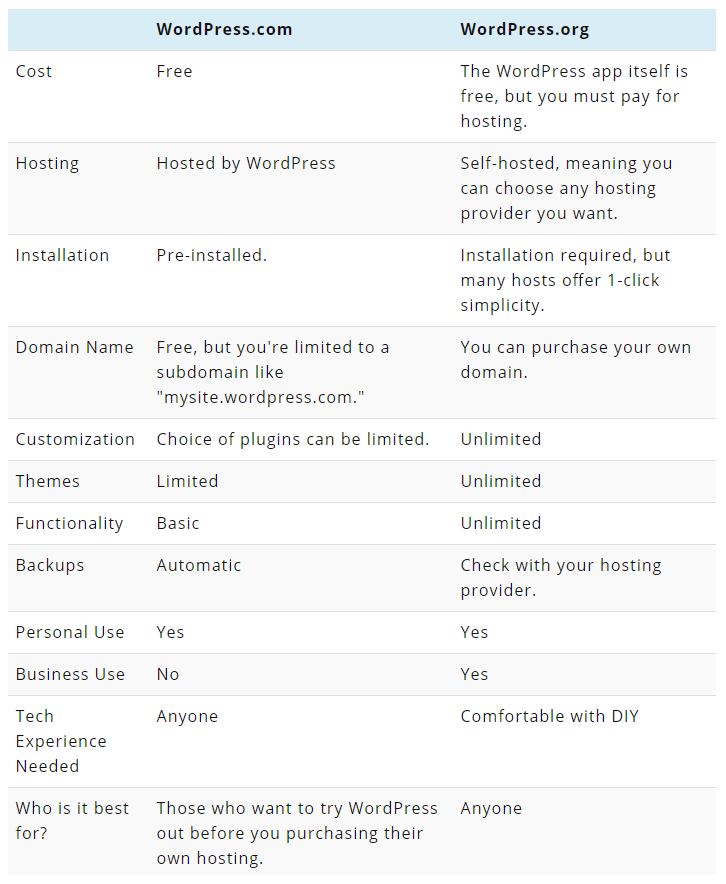
2.Choosing Web Hosting and Domain Name
Your web hosting: Web hosting, in simple terms, is where your blog is digitally stored. While your blogging platform is the “house” your blog lives in, your web hosting is like the city.
Click here or the photo above to sign up for a SiteGround hosting account. Make sure to choose “Wordpress Hosting”.
We recommend Siteground because you can’t beat the bandwidth, speed, and yearly low price! 🙂
We’ve been using them since we started this blog and it comes with a free domain name. Also installing WordPress is as easy as just one click so there’s no way you can mess it up.
Important features you will want from your web hosting company:
When choosing your web hosting company there are certain ‘services offered’ that you want to look for, these include:
- Security services like SSL Certificates, site backup, and site monitoring
- Easy one-click WordPress installations
- Enough bandwidth and disk space needed for your site (depends on your traffic levels)
- High performance and speed for your site
- Fair pricing (like 12-month low price)
- Customer service and support team (email, phone calls, live chats)
This is why we recommend using SiteGround for your first blog!
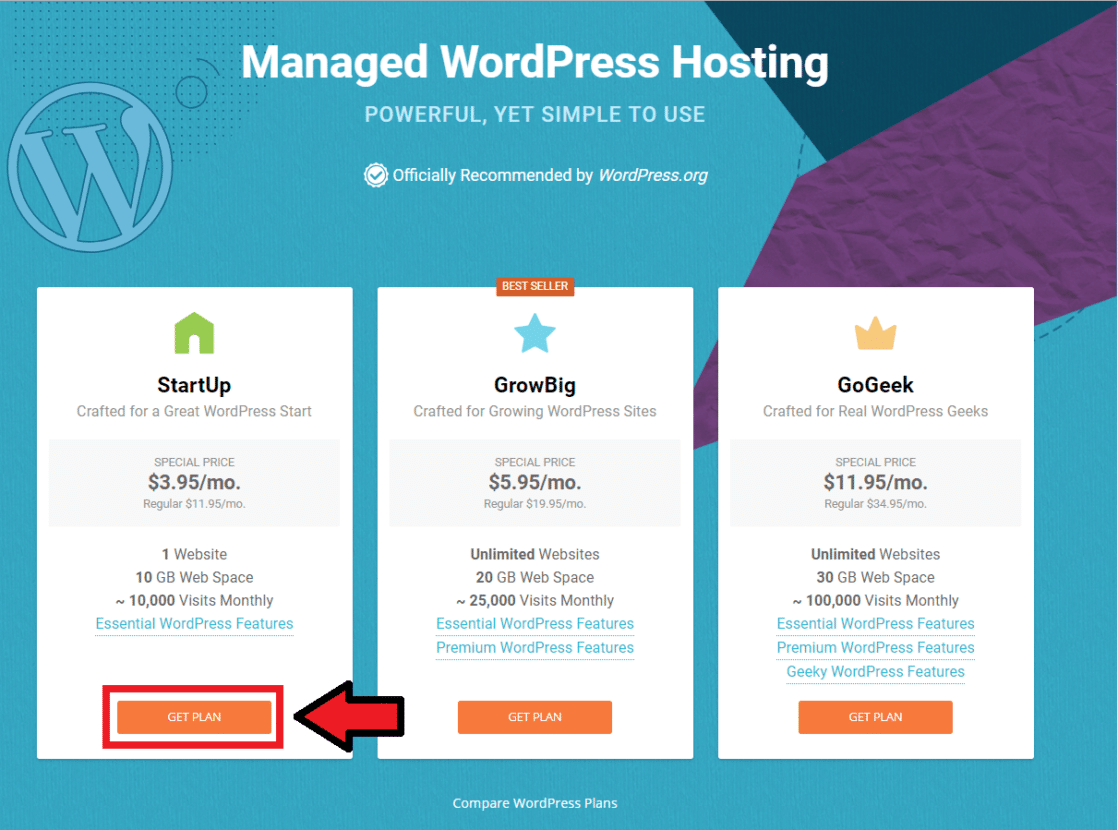
Installing WordPress isn’t difficult, in fact, WordPress is famous for their “5-minute install”.
SiteGround will install WordPress for you. And what we love about them is that you get the low price by selecting their 12-month plan. You’re not locked in for 36 months like with other hosting companies.
Now that you’ve chosen your blogging platform, let’s move on. The next step is picking a domain name and setting up your web hosting. Let’s go over the two.
Your domain name: is the URL or website address to your website/blog. For example, startupbros.com. When choosing your domain, you want to think…
Simple. Short. Catchy. Relevant. Easy-to-remember.
Once we sign up for a hosting account we can register the domain name. So just keep your domain name handy.
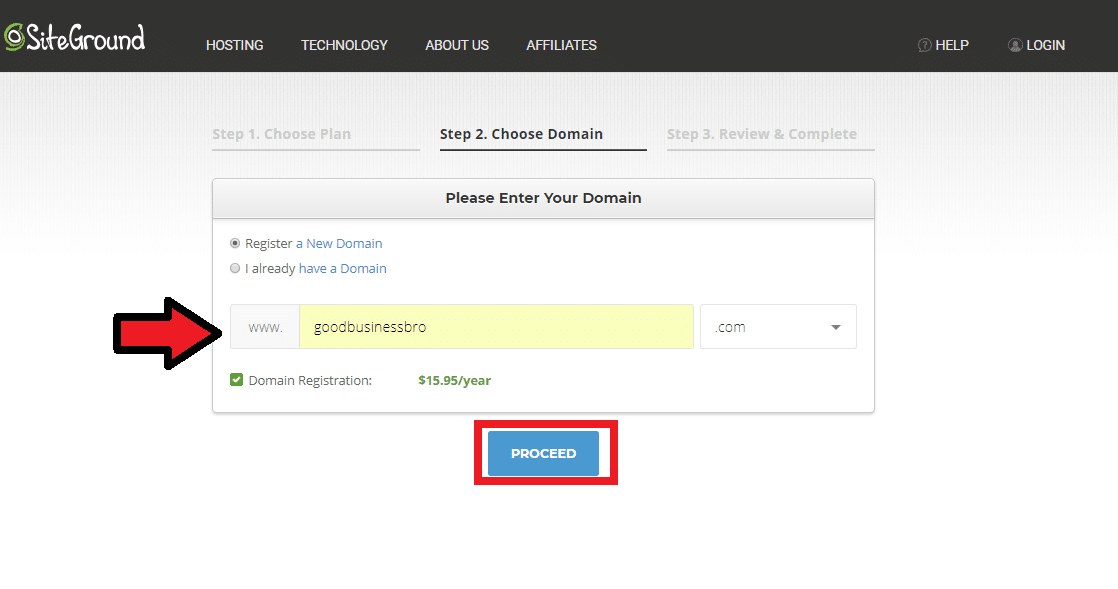
When we say relevant in the above description, we mean, relevant to your blog and the topics you will be writing about. We will talk more about the focus of your blog and topics in Step 4: Designing your blog.
And Although you will have options for .org, and so on, .com is usually the best to go with and most easily remembered as well as most often used.
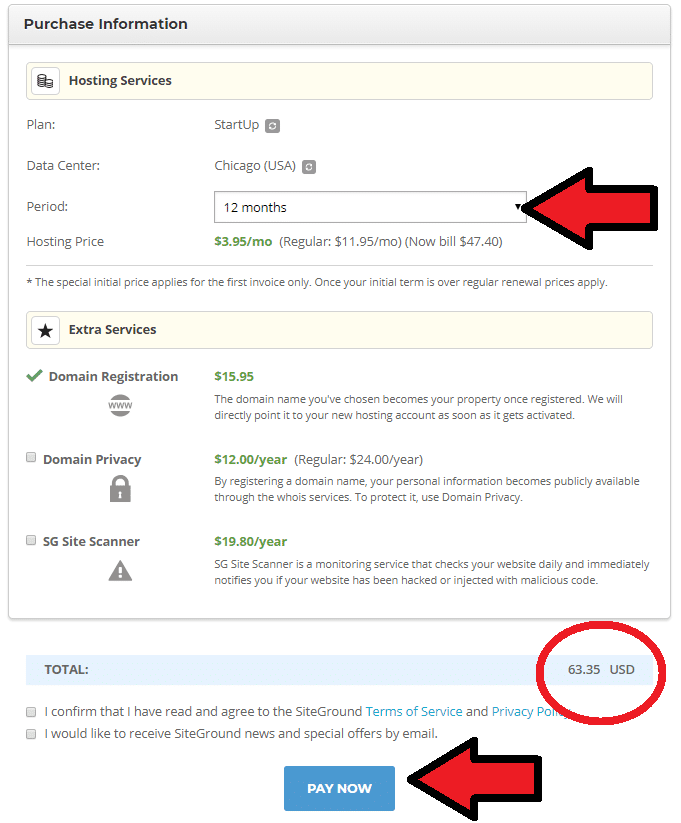
You can’t beat that low price. Keeping startup costs low is important for anyone starting a blog for the first time.
You’re going to have a great looking website up and running for $64 dollars…
3. Set Up Your Blog on Your Host Account (installing WordPress)
After you pay for your hosting account, you’re directed to set up your first website!
Pretty quick huh?
Well, don’t stop the momentum!
Let’s walk you step by step on setting up your first WordPress site:
You don’t need any add-ons so just click the confirm box.
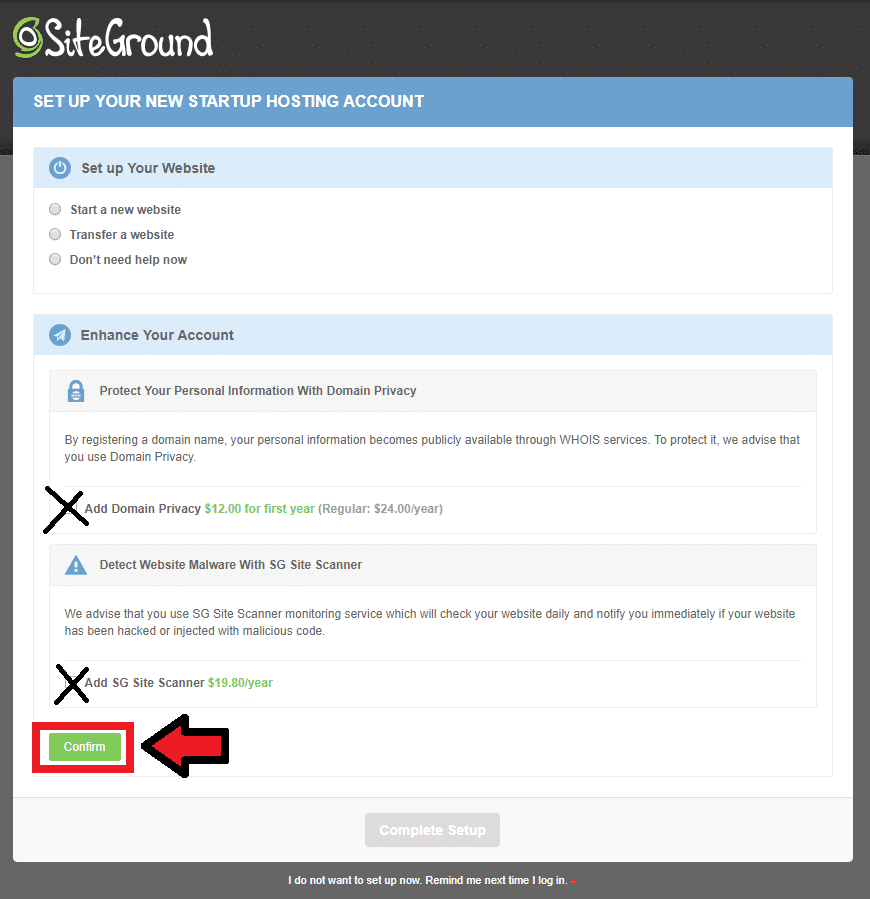
You want to start a new website and then select WordPress.
It’s going to ask you to set up your first user account…
Make sure to write this information somewhere!
Admin Email: Can be your personal email to start
Username: Can be your name with no spaces or with spaces “willmitchell” “Will Mitchell”
Password: Make it something difficult and write it somewhere
Once you submit the information your WordPress site will have the first user account. Keep going to finish the setup
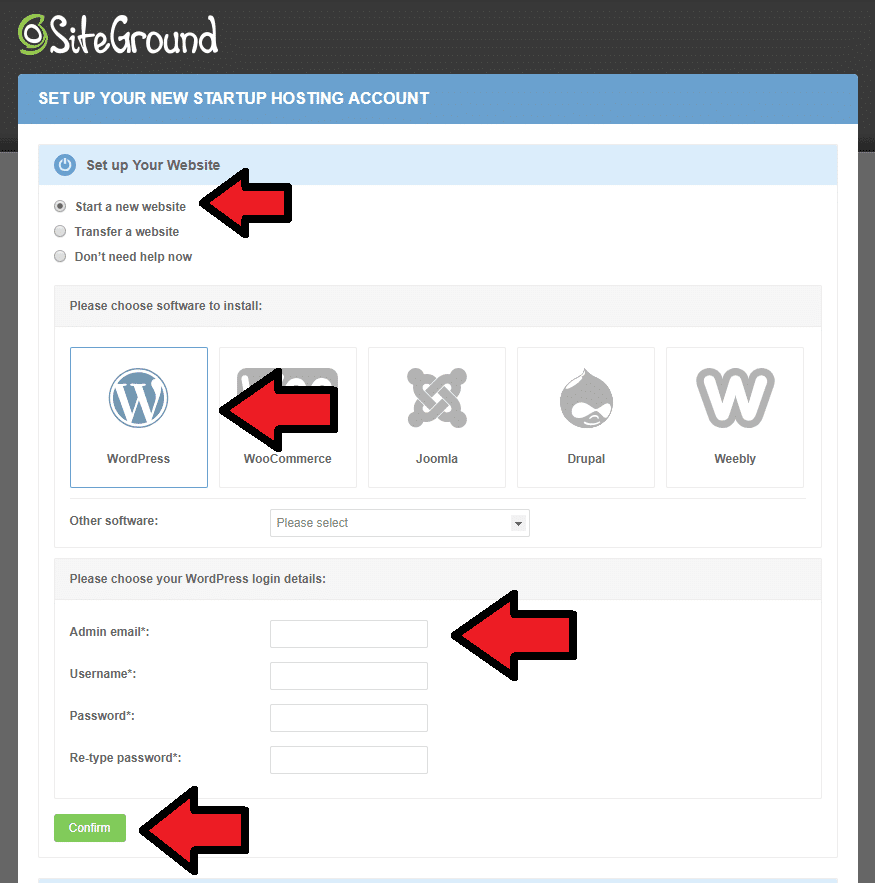
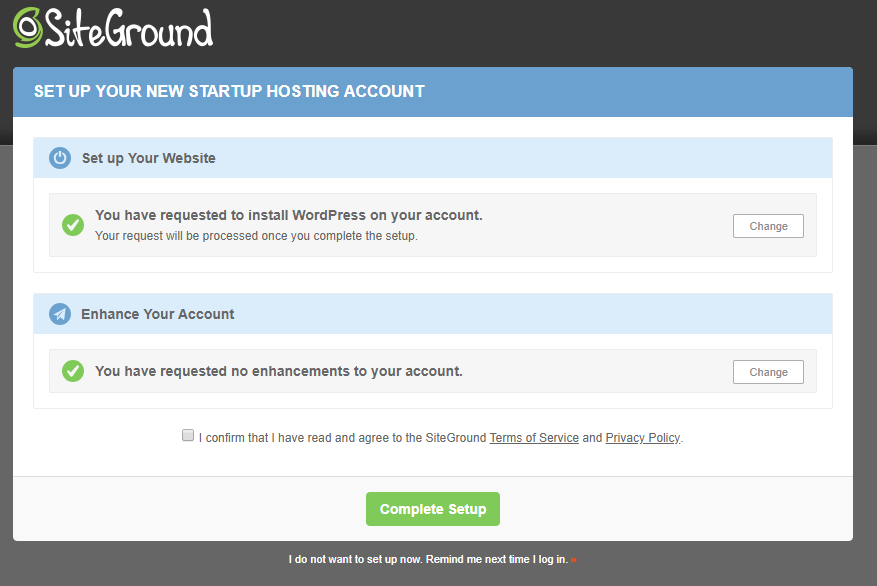
SiteGround is going to suggest that you install certain plugins.
You don’t need them.
On page 3/3 you’re going to want Google analytics and Yoast SEO so make sure to select those.
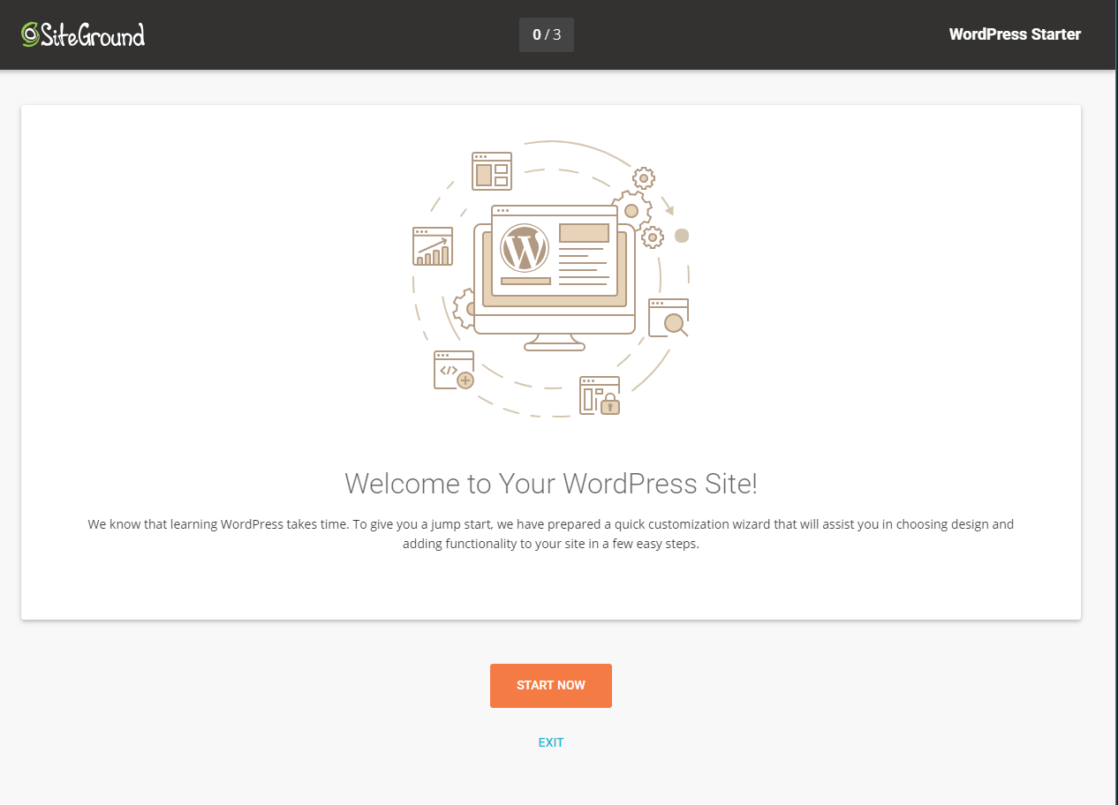
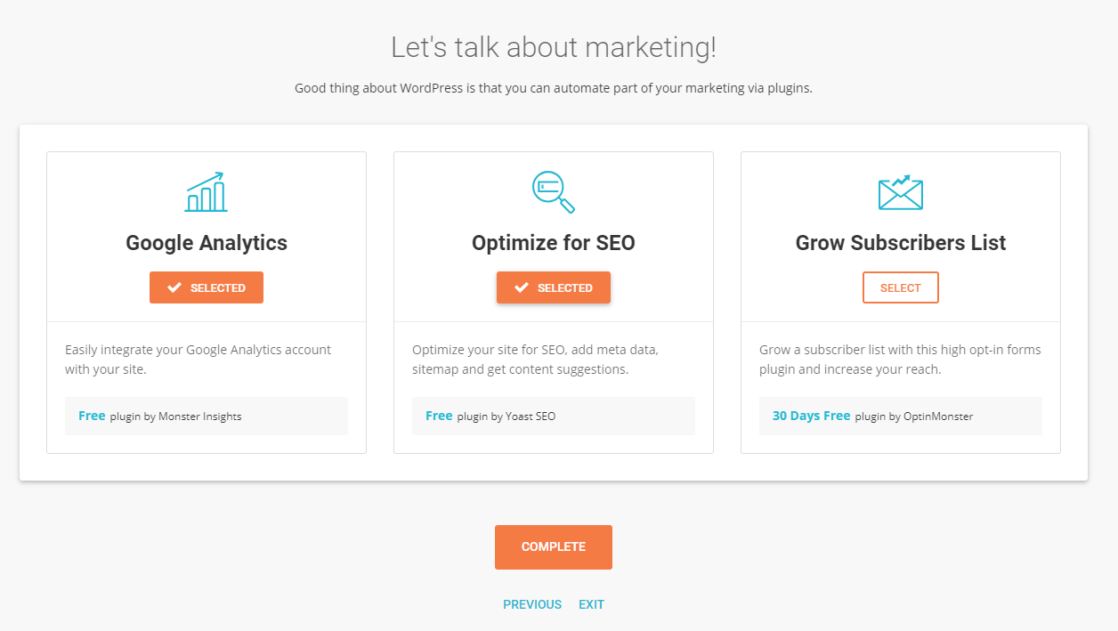
Complete the installation and that’s it!
You’ve just created your first Wordpress site 🙂
There should be an email in your inbox at this point notifying you of your new WordPress account and how to log in.
4. Design Your Blog: Choose Your Theme
It’s time to pick an awesome theme for your site!
You get to pick from a ton of cool themes and most of them are free.
There’s no need to make this more complicated than it needs to be. The name of the game is to get started and minimize the amount of time you waste.
You need to learn how to use WordPress and the only way to learn is to take action. Don’t spend time looking for the perfect theme or paying for the best software.
Once you’re comfortable with the way everything works then you can invest in making improvements.
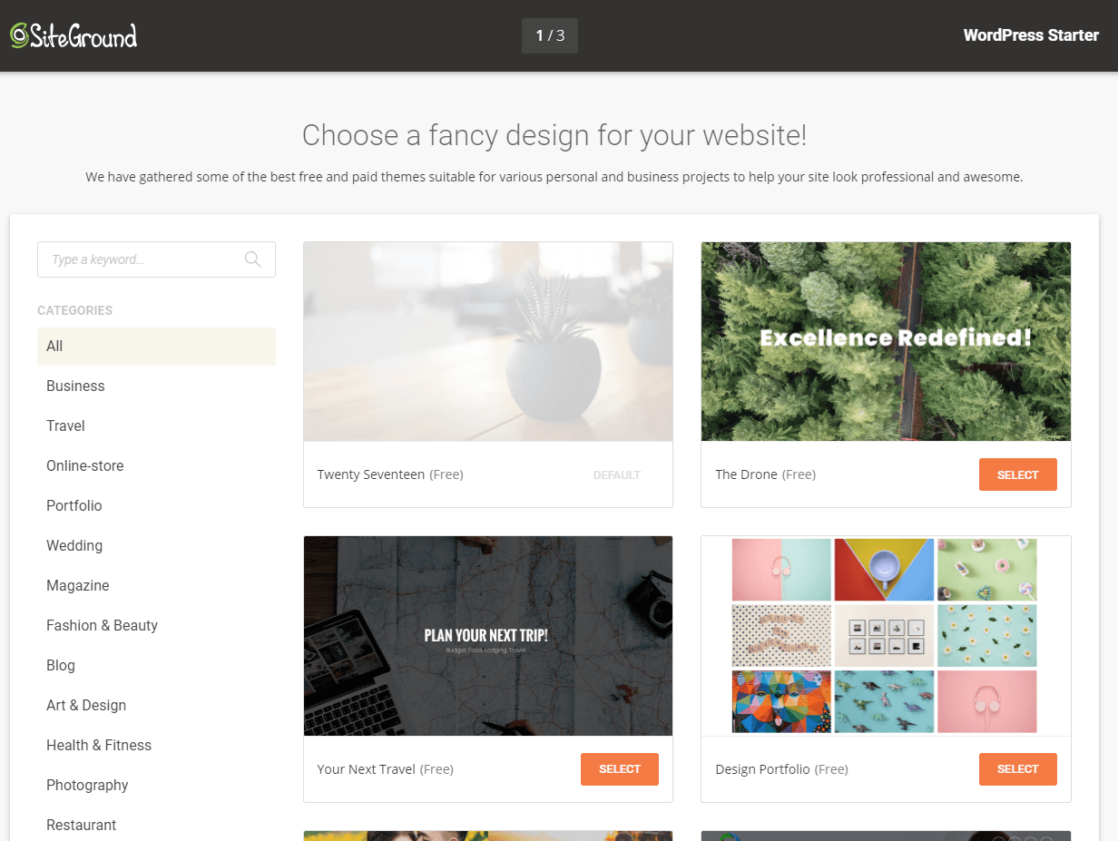
Our first theme, if you remember from the picture above, was a simple blogging theme.
Back in 2012 when we started this website it was difficult to import the exact layout they show you in the previews.
Now it’s much easier…
Once you select a theme you like, SiteGround is going to import the demo content as your website.
That way you’ll have the exact layout in the theme you selected.
Then what’s left for you is to replace all of the demo content with your own and it’s more like personalizing your site instead of starting from scratch.
Super cool!
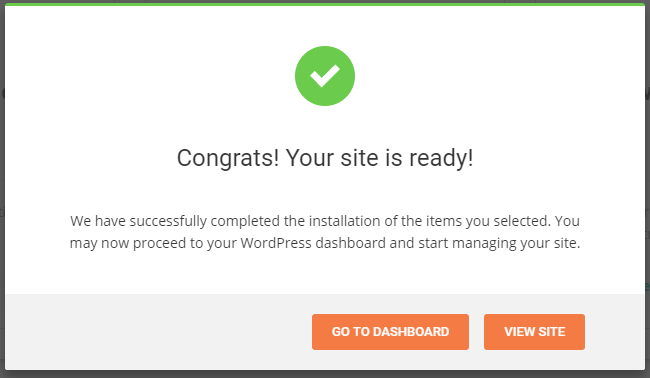
(Bonus) Launch your blog! … and rank
Congratulations, you have made it to the “final” step!
The good news is if you have made it this far then you are ready to create and publish your first post.
Now comes the real work though, the journey to making sure that your blog is successful and ranking.
What do we mean by ranking?
…Basically, this means two things.
You need to create high-quality content and get that content in front of people.
So now you’re wondering, how to start ranking with your blog…
What are the basic key factors in creating rank-worthy content?
- Communication to a niche/target audience (aesthetically and with your blog posts)
- Creating high-quality content (over quantity)
- Utilizing keywords and other important SEO tactics
- Promoting your content
Find your target audience/niche
Having a target audience is one of the most important pieces of the puzzle to have a successful blog.
Once you select your topic, you need to narrow it down even more.
You need to find a niche. Find something that will make your blog unique and different from all the other ones in your blogging category.
Take note of the different demographics of the audience you are “writing to”.
Who are you writing to?
Take a look at the following questions and narrow the answers down as much as you can.
- Are you writing to a predominantly male or female audience?
- What is the age range of audience you are writing to?
- Where is your audience located?
- What types of careers do your audience members have?
- What types of hobbies do your audience members participate in?
When you design your blog and write your posts, always keep your audience in mind. Think of it as if you are writing directly to the “general” member of your audience.
Create high-quality content
It’s also important to remember that you should focus on quality over quantity.
Instead of posting as much as you can, rather post less often but post higher quality content.
If you have high-quality content you are naturally more prone to make your way to the SEO results that you desire.
Also, when getting started, go ahead and decide on how often you plan on [realistically] posting.
Once a week? Twice a week? Choose a day and time that works best for you and stick to it.
This not only ensures that you are more likely to get it done (because it is on your calendar) but your readers will also know when to expect new material.
When it comes to your posts, the quality of your writing will improve over time, but to get started, try sticking to the following format:
As a basic skeleton of what your blog posts should look like go with this:
- A great headline
Your headline is the first thing your viewers will read. If it doesn’t catch their attention or draw their interest, then they likely are going to move past it.
- An eye-catching picture
People are very visual creatures. A visual will grab their interest and motivate them to read forward. People are also innately lazy creatures, they won’t be convinced to read unnecessarily unless you motivate them with a quick and easy visual representation.
- An introduction to your post
This is the next most vital piece to your post. Your audience needs to read the introduction to get an idea of what else they are going to learn.
- A transition/lead into your main points
Gently guide your readers into your post. Use this section to lead them into your main points.
- Your main points
Here is where the meat of your post will lie. This section is where you deliver the heart and soul of your post – the information that you want to communicate.
Audiences understand better when they read an article with bullet points, graphics, headlines, and bolded and italicized text…
This helps them to read easy. Remember that you are responsible for guiding them!
- Your conclusion
Wrap up your post with a final idea that highlights all of the ideas mentioned prior. The conclusion should emphasize what new information your readers have learned.
- An invitation/option for feedback from your readers
Feedback and comments from your readers are more beneficial than you might think, it is free data!
When you invite your readers to let you know what they think, it gives you a free opportunity for user data.
Use this data to adjust your tone, writing, points, etc., in a way that best pleases them and grows your blog!
Find keywords and other important SEO tactics
The best and most simple way to engage in SEO is to create appealing and high-quality content as well as promote it (social media, guest blogging, etc.). From there you can let the links and shares to your post come organically. However, as competition is high, you will want to implement other marketing tactics in order to be a successful blogger and gain higher traffic levels to your site.
Do keyword research before you write
Knowing what keywords work and how audiences engage with them will set you up for success when writing your posts. Do your research beforehand to get a good sense of what will bring in traffic to your site.
When doing your research, you will want to know the background and action of particular keywords. If a certain keyword is being dominated by the bigger businesses (i.e., large-scale websites like Wikipedia, etc.) then you might want to narrow your keyword down, as in, make your keywords more specific. For example, instead of using “great recipes,” using “great recipes for beginner cooks,” etc. Find keywords with decently low-ranking difficulty within your relevant niche.
Once you have researched your keywords, create a list that you can refer back to as you write your post. You can even cross them out as you use them, making sure that you do in fact use them. A great way to build your keywords lists is to use the Google Keywords Planner.
Build backlinks to draw more traffic to your site and boost your rankings
Part of blogging successfully is building relationships and connections. In this scenario that
means link building. Backlinks to your site is a seriously strong indicator for Google when it comes to rankings. In simple and very basic terms, the way to get backlinks is to:
- Build relationships
- Target an audience that can provide links
- Create high-quality content
- Reach out to anyone that you have linked in your article (this can be a multi-beneficial relationship)
To learn a bit more about link building, check out these strategies by Ryan Stewart. There are of course many other ways to build backlinks that you can look into, but as a beginner, we suggest you start with the above.
Use internal links to create a map to and of your site
Internal links are simply links in your post that send the reader to other posts or pages on your site. Using internal links is another way to help with your SEO, as well as navigate readers around your blog. Using internal links also helps provide more traffic to your older posts, and other pages on your site, etc.. Even if a single post of yours ranks highly in search engines, it will help promote your blog and site as a whole.
Promote your blog
Remember the importance of networking. Get involved in the online blogging community. Team up with other bloggers and influencers and utilize one another to grow your audiences.
You should be spending a good chunk of time promoting your blog. Jump on to social media to share and promote your blog, as well as forums and groups. Consider participating and promoting on platforms such as Reddit, Quora, Slack, etc.
You can also join in on Twitter chains, Facebook groups, and LinkedIn groups to find users that would potentially fit your ideal audience member and promote your blog. An important note: you don’t have to do all of your promotion alone, you can reach out to experienced digital marketing companies that have the resources at their fingertips to help you grow your website.
Conclusion
Now, with the knowledge you’ve learned, you can now start creating some awesome content and make your way to blog success. As you make your way, remember these important things:
- Create high-quality content
- Post consistently
- Focus on your target audience
- Think of niche-topics
- The uniqueness of brand and blog
- Promote your posts
- Network
If you keep these important tips in mind, then you’ll be off to a great start in becoming a successful blogger.
What domain name did you pick? Comment below and I would love to talk about your new blog with you!

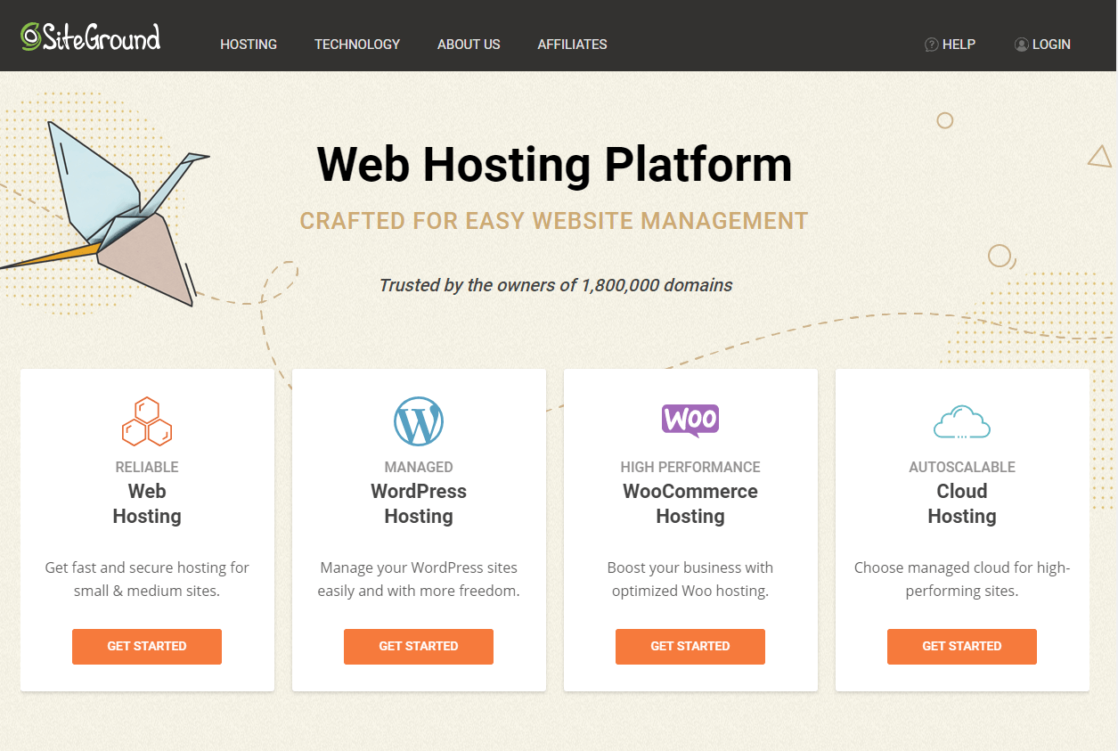
Thank you for the wonderful content. I could find some helpful tips here.
Thanks for checking out the article!
Hi Will,
Thank you for the awesome article! I think the key for a successful blog is finding a niche you are personally passionate about and can help others. If your are knowledgeable about the niche you can create really good content in that niche.
Again, thanks and more power! 🙂
Hey Chester, you’re absolutely right! It’s all about passion because it helps us stick with blogging 🙂 So glad you enjoyed the article!
I agree with you, blogging can bring full time income in short time. So working on it productively can bring much profits and success to bloggers. With these steps you mentioned, we can create awesome blogs and can get profits from it. keep sharing new updates.